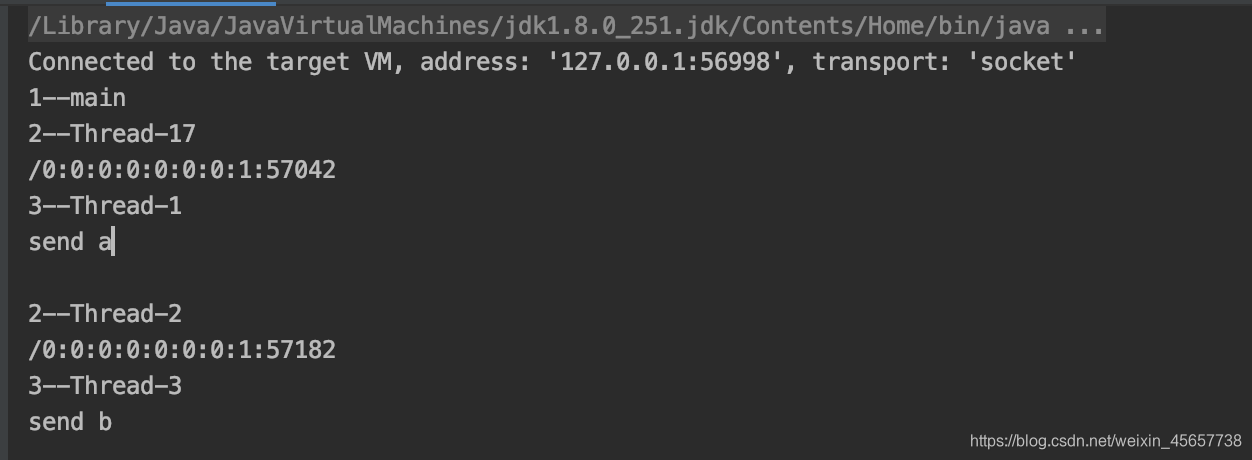主要研究 NIO与EPOLL
探讨深度 Java代码 -> HotSpot源码 -> linux函数
一. BIO
1 public static void main(String[] args) throws IOException {
2 ServerSocket serverSocket = new ServerSocket(9000);
3
4 while (true) {
5 Socket socket = serverSocket.accept();
6 byte[] buffer = new byte[1024];
7 int read = socket.getInputStream().read(buffer);
8 if (read != 0) {
9 String data = new String(buffer, 0, read);
10 System.out.println(data);
11 OutputStream outputStream = socket.getOutputStream();
12
13 outputStream.write(data.getBytes());
14 outputStream.flush();
15 socket.close();
}
}
}
终端命令:

debug启动时, 会发现pc指针会在第5行阻塞, 我们启终端 telnet localhost 9000
指针会继续执行, 再次阻塞在第7行, 这时我们在终端 send bio test, pc会继续执行
期间终端再启一个控制台, 去telnet发现也是被阻塞的 后发送会等第一个执行完再执行后面的
idea console如下:

二. NIO
- 不使用多路复用, 单纯的非阻塞
public static void main(String[] args) throws IOException {
List<SocketChannel> clientSocketList = new ArrayList<>(1024);
ServerSocketChannel serverSocketChannel = ServerSocketChannel.open();
serverSocketChannel.socket().bind(new InetSocketAddress(9000));
serverSocketChannel.configureBlocking(false);
while (true) {
SocketChannel clientSocket = serverSocketChannel.accept();
if (clientSocket != null) {
clientSocket.configureBlocking(false);
clientSocketList.add(clientSocket);
}
Iterator<SocketChannel> iterator = clientSocketList.iterator();
while (iterator.hasNext()) {
SocketChannel sc = iterator.next();
ByteBuffer dst = ByteBuffer.allocate(1024);
int len = sc.read(dst);
if (len > 0) {
System.out.println("接收到消息: " + new String(dst.array()));
}
}
}
}
从上面代码我们就发现设置了一个很重要的参数configureBlocking(false), 设置为非阻塞, accept和read都不阻塞, 进来的socket都放到了一个容器了, 然后循环便利这个容器, 看是否有inputStream流数据, 有则输出, 继续下次循环.
开启两个终端telnet localhost 9000
第一个send a
第二个send b
IDEA console如下:

这段代码例子, (可以理解为)就是linux的select的工作原理, 而poll就是把clientSocketList容器的最大值设置为Integer.MAX_VALUE.
- 重点在这里!!!
重点在这里!!!
重点在这里!!!
重点在这里!!!
重点在这里!!!
使用多路复用Selector
public static void main(String[] args) throws IOException {
ServerSocketChannel serverSocketChannel = ServerSocketChannel.open();
serverSocketChannel.socket().bind(new InetSocketAddress(9000));
serverSocketChannel.configureBlocking(false);
// linux epoll_create
Selector selector = Selector.open();
// linux epoll_ctl
serverSocketChannel.register(selector, SelectionKey.OP_ACCEPT);
while (true) {
// linux epoll_wait rdList epoll的就绪队列有事件 才会继续执行
selector.select();
Set<SelectionKey> selectionKeys = selector.selectedKeys();
Iterator<SelectionKey> iterator = selectionKeys.iterator();
while (iterator.hasNext()) {
SelectionKey sk = iterator.next();
if (sk.isAcceptable()) {
ServerSocketChannel server = (ServerSocketChannel) sk.channel();
SocketChannel sc = server.accept();
sc.configureBlocking(false);
sc.register(selector, SelectionKey.OP_READ);
System.out.println("客户端连接成功");
} else if (sk.isReadable()) {
SocketChannel sc = (SocketChannel) sk.channel();
ByteBuffer dst = ByteBuffer.allocate(1024);
int len = sc.read(dst);
if (len > 0) {
System.out.println("接收到消息: " + new String(dst.array()));
}
}
iterator.remove();
}
}
}
第一个终端 telnet localhost 9000
第二个终端 telnet localhost 9000
第一个终端 send a
第二个终端 seng b
第一个终端 send c
IDEA console如下:

!!! 这段代码, 主要引入了一个在linux运行jdk时候, 就是EPOLL的相关操作. 服务端和连接进来的socket分别注册了OPEN和READ事件, 没有事件时会阻塞在select()方法里, 当有相关事件就会进行接下来的代码逻辑执行.
接下来我们重点看Selector的 open, register, select三个方法, 到底做了什么东西.
// open方法 jdk源码
public static Selector open() throws IOException {
return SelectorProvider.provider().openSelector();
}
public static SelectorProvider provider() {
synchronized (lock) {
if (provider != null)
return provider;
return AccessController.doPrivileged(
new PrivilegedAction<SelectorProvider>() {
public SelectorProvider run() {
if (loadProviderFromProperty())
return provider;
if (loadProviderAsService())
return provider;
// 重点create方法 这里直接点进去 会根据下载的jdk pc版本进入不同方法 我们直接去openjdk源码里看Epoll的实现
provider = sun.nio.ch.DefaultSelectorProvider.create();
return provider;
}
});
}
}
!!! 源码分析
// open jdk源码
public static SelectorProvider create() {
String osname = AccessController
.doPrivileged(new GetPropertyAction("os.name"));
if (osname.equals("SunOS"))
return createProvider("sun.nio.ch.DevPollSelectorProvider");
if (osname.equals("Linux"))
return createProvider("sun.nio.ch.EPollSelectorProvider");
// 到这个类里去看
return new sun.nio.ch.PollSelectorProvider();
}
public class EPollSelectorProvider
extends SelectorProviderImpl
{
public AbstractSelector openSelector() throws IOException {
// return了一个实现类
return new EPollSelectorImpl(this);
}
public Channel inheritedChannel() throws IOException {
return InheritedChannel.getChannel();
}
}
EPollSelectorImpl(SelectorProvider sp) throws IOException {
super(sp);
long pipeFds = IOUtil.makePipe(false);
fd0 = (int) (pipeFds >>> 32);
fd1 = (int) pipeFds;
try {
// new了一个EPollArrayWrapper
pollWrapper = new EPollArrayWrapper();
pollWrapper.initInterrupt(fd0, fd1);
fdToKey = new HashMap<>();
} catch (Throwable t) {
try {
FileDispatcherImpl.closeIntFD(fd0);
} catch (IOException ioe0) {
t.addSuppressed(ioe0);
}
try {
FileDispatcherImpl.closeIntFD(fd1);
} catch (IOException ioe1) {
t.addSuppressed(ioe1);
}
throw t;
}
}
// EPollArrayWrapper里
EPollArrayWrapper() throws IOException {
// creates the epoll file descriptor
// 我们都知道linux里 一切皆是文件 所以创建了一个epoll
epfd = epollCreate();
// the epoll_event array passed to epoll_wait
int allocationSize = NUM_EPOLLEVENTS * SIZE_EPOLLEVENT;
pollArray = new AllocatedNativeObject(allocationSize, true);
pollArrayAddress = pollArray.address();
// eventHigh needed when using file descriptors > 64k
if (OPEN_MAX > MAX_UPDATE_ARRAY_SIZE)
eventsHigh = new HashMap<>();
}
// 三个核心native方法
private native int epollCreate();
private native void epollCtl(int epfd, int opcode, int fd, int events);
private native int epollWait(long pollAddress, int numfds, long timeout, int epfd) throws IOException;
// 我们先拿epollCreate()举例, 我们要去看c语言如何实现这个方法, 那么拿类名加下划线和方法名,
// EPollArrayWrapper_epollCreate
JNIEXPORT jint JNICALL
Java_sun_nio_ch_EPollArrayWrapper_epollCreate(JNIEnv *env, jobject this)
{
/*
* epoll_create expects a size as a hint to the kernel about how to
* dimension internal structures. We can't predict the size in advance.
*/
// 就是这个epoll_create linux中的方法 C语言可以直接调用它
// 在linux里用man命令可以查看相关方法的详细描述
int epfd = epoll_create(256);
if (epfd < 0) {
JNU_ThrowIOExceptionWithLastError(env, "epoll_create failed");
}
return epfd;
}
以上就是selector的open分析 jdk源码 -> hotspot源码 -> linux语法概要
register 对应 epollCtl, epollCtl相当于注册一个事件
select 对应 epollWait, epollWait相当于绑定了这个事件 并且监听
三. AIO
public static void main(String[] args) throws IOException, InterruptedException {
AsynchronousServerSocketChannel serverChannel = AsynchronousServerSocketChannel.open().bind(new InetSocketAddress(9000));
serverChannel.accept(null, new CompletionHandler<AsynchronousSocketChannel, Object>() {
@Override
public void completed(AsynchronousSocketChannel socketChannel, Object attachment) {
try {
System.out.println("2--"+Thread.currentThread().getName());
// 再此接收客户端连接,如果不写这行代码后面的客户端连接连不上服务端
serverChannel.accept(attachment, this);
System.out.println(socketChannel.getRemoteAddress());
ByteBuffer buffer = ByteBuffer.allocate(1024);
socketChannel.read(buffer, buffer, new CompletionHandler<Integer, ByteBuffer>() {
@Override
public void completed(Integer result, ByteBuffer buffer) {
System.out.println("3--"+Thread.currentThread().getName());
buffer.flip();
System.out.println(new String(buffer.array(), 0, result));
socketChannel.write(ByteBuffer.wrap("HelloClient".getBytes()));
}
@Override
public void failed(Throwable exc, ByteBuffer buffer) {
exc.printStackTrace();
}
});
} catch (IOException e) {
e.printStackTrace();
}
}
@Override
public void failed(Throwable exc, Object attachment) {
exc.printStackTrace();
}
});
System.out.println("1--"+Thread.currentThread().getName());
Thread.sleep(Integer.MAX_VALUE);
}
启动第一个终端执行 telnet localhost 9000和send a
启动第二个终端执行 telnet localhost 9000和send b
IDEA console如下:

BIO, NIO在代码案例中, 都是main线程去执行的, 而这个AIO就是线程如此多.
四. 总结
BIO, NIO, AIO主要的区别分为两个阻塞与非阻塞, 同步与非同步
从第一个和第二个例子, 我们可以理解出阻塞与非阻塞的区别.
从第三个和第四个例子, 我们可以看出同步与非同步的区别.

1.4之后出现NIO, 先是采用linux的 select 后采用poll
1.5及之后采用了epoll的IO多路复用架构
